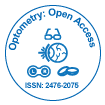Intraocular Pressure: A Key Factor in Eye Health
Received: 03-May-2025 / Manuscript No. omoa-25-171443 / Editor assigned: 05-May-2025 / PreQC No. omoa-25-171443 / Reviewed: 17-May-2025 / QC No. omoa-25-171443 / Revised: 23-May-2025 / Manuscript No. omoa-25-171443 / Published Date: 29-May-2025 DOI: 10.4172/2476-2075.1000316
Introduction
Intraocular pressure (IOP) refers to the fluid pressure within the eye, maintained by the balance between the production and drainage of aqueous humor. It is a critical parameter in ocular physiology, as deviations from normal levels can lead to vision-threatening conditions. Elevated IOP is a major risk factor for glaucoma, the leading cause of irreversible blindness worldwide. Conversely, abnormally low IOP, though less common, may indicate ocular trauma or systemic disease. Understanding the regulation, measurement, and implications of IOP is essential for maintaining eye health and preventing disease progression [1,2].
Discussion
IOP is primarily determined by the dynamics of aqueous humor, a clear fluid produced by the ciliary body. This fluid nourishes the avascular structures of the eye, including the lens and cornea, while maintaining ocular shape. Aqueous humor exits the eye through the trabecular meshwork and Schlemm’s canal in the anterior chamber angle, as well as through the uveoscleral pathway. Any imbalance in production or drainage can lead to abnormal pressure levels [3-6].
Normal IOP generally ranges between 10 and 21 mmHg, though individual variation exists. Elevated IOP, or ocular hypertension, increases stress on the optic nerve head, potentially causing glaucomatous optic neuropathy. Glaucoma may remain asymptomatic in early stages, making regular monitoring of IOP critical, particularly in high-risk populations such as older adults, individuals with a family history of glaucoma, or those with myopia or diabetes [7,8].
IOP measurement, or tonometry, is a cornerstone of glaucoma screening and ocular assessment. Goldmann applanation tonometry is considered the gold standard, providing accurate and reproducible readings. Non-contact tonometry, also known as “air puff” tonometry, offers a quick, patient-friendly alternative. Advances in technology have introduced continuous IOP monitoring devices, such as contact lens sensors, which provide real-time data and insights into diurnal variations, critical for understanding disease progression [9,10].
Low IOP, or hypotony, may result from trauma, postoperative complications, or chronic inflammatory conditions. Hypotony can lead to structural changes in the eye, corneal edema, or vision loss if prolonged. Both high and low IOP require careful assessment and management tailored to the underlying cause.
Management of abnormal IOP focuses on preserving optic nerve health and preventing vision loss. Elevated IOP is typically addressed through topical medications such as prostaglandin analogs, beta-blockers, or carbonic anhydrase inhibitors.
Conclusion
Intraocular pressure is a vital parameter in ocular health, influencing the risk of glaucoma and other eye conditions. Regular monitoring, accurate measurement, and timely intervention are essential for maintaining visual function and preventing irreversible damage. With advancements in diagnostic technologies and therapeutic options, clinicians can better manage IOP fluctuations and tailor treatments to individual patients. Awareness of IOP’s role underscores the importance of routine eye examinations and proactive management strategies, ultimately protecting vision and enhancing quality of life.
References
- Behrens A, Doyle JJ, Stern L (2006) Dysfunctional tear syndrome: A Delphi approach to treatment recommendations. Cornea 25: 900–907.
- Nakamura H, Kawakami A, Eguchi K (2006) Mechanisms of autoantibody production and the relationship between autoantibodies and the clinical manifestations in Sjogren's syndrome. Transl Res 148: 281–288.
- Vitali C, Bombardieri S, Jonsson R (2002) Classification criteria for Sjogren's syndrome: a revised version of the European criteria by the American-European Consensus Group. Ann Rheum Dis 61:554-558.
- Smith JA, Albenz J, Begley C (2007) The epidemiology of dry eye disease: report of the epidemiology subcommittee of the international Dry Eye Workshop (2007). Ocul Surf 5: 93–107.
- Miljanovic B, Dana R, Sullivan DA, Schaumberg DA (2007) Impact of dry eye syndrome on vision-related quality of life. Am J Ophthalmol 143: 409–415.
- Schaumberg DA, Sullivan DA, Buring JE, Dana MR (2003) Prevalence of dry eye syndrome among US women. Am J Ophthalmol 136: 318–326.
- Schaumberg DA, Sullivan DA, Dana MR (2002) Epidemiology of dry eye syndrome. Adv Exp Med Biol 506: 989–998.
- Moss SE, Klein RK, Klein BEK (2000) Prevalence of and risk factors for dry eye syndrome. Arch Ophthalmol 118: 1264–1268.
- Gayton JL (2009) Etiology, prevalence, and treatment of dry eye disease. Clin Ophthalmol 3: 405–412.
- Clegg J, Guest J, Lehman A, Smith A (2006) The annual cost of dry eye syndrome in France, Germany, Italy, Spain, Sweden and the United Kingdom among patients managed by ophthalmologists. Ophthalmic Epidemiol 13: 263–274.
Citation: Amina H (2025) Intraocular Pressure: A Key Factor in Eye Health. Optom Open Access 10: 316. DOI: 10.4172/2476-2075.1000316
Copyright: © 2025 Amina H. This is an open-access article distributed under the terms of the Creative Commons Attribution License, which permits unrestricted use, distribution, and reproduction in any medium, provided the original author and source are credited.
Select your language of interest to view the total content in your interested language
Share This Article
Recommended Journals
Open Access Journals
Article Tools
Article Usage
- Total views: 138
- [From(publication date): 0-0 - Dec 19, 2025]
- Breakdown by view type
- HTML page views: 111
- PDF downloads: 27
